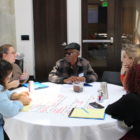
California Is Becoming a Model of Juvenile Justice Reform, Thanks to Progressive Legislation
|
California has evolved from having one of the most draconian, costly juvenile justice systems to becoming a model of reform.
Juvenile Justice Information Exchange (https://jjie.org/tag/california/page/5/)

California has evolved from having one of the most draconian, costly juvenile justice systems to becoming a model of reform.

As juvenile justice reforms take hold in California and youth arrests rates plunge, far fewer youth are being placed into the criminal justice system and prosecuted as adults.

Aswad Thomas was a recent college graduate headed to the European basketball leagues in 2009 when he was shot in the back in Hartford, Conn., eight times. He was temporarily paralyzed with one bullet an inch away from his spine, had two collapsed lungs and extensive internal bleeding.

In July, a group of advocates from across California met in Sacramento, just blocks from the State Capitol, for the Next Generation Fellowship, a six-day leadership development and policy advocacy training for emerging community leaders. Amid differences in age, race/ethnicity and gender, each of the 15 fellows share a powerful connection: They have been directly impacted by the justice system.

The current attempt to amend the felony murder rule in California has been a multiyear effort. This work, like all our work, was borne out of our personal experiences with clients, incarcerated individuals and family members with loved ones serving life sentences under this antiquated doctrine. This rule represented to us an injustice that deserved a remedy.

Last fall, the Miami Herald exposed alarming abuses within Florida’s Department of Juvenile Justice, including guard-sanctioned beatings, excessive use of force and rampant violence. Likewise, in late 2017, reporters at the Dallas Morning News uncovered sexual abuse by staff in the Texas Juvenile Justice Department. These discoveries were troublingly reminiscent of California’s Division of Juvenile Justice, which has been mired in scandal for much of its decadeslong history, including a spate of violent incidents, youth suicides and staff misconduct in the early 2000s that resulted in a 12-year consent decree.

What should be the cost of a terrible mistake? On Nov. 4, 2013, two young people’s lives tragically intersected on a bus in Oakland, Calif. That afternoon, Oakland’s 57 bus carried Richard and Sasha home after school.

Juvenile justice reinvestment, which shifts funding from corrections-based approaches toward cost-effective community-based services for youth, has gained momentum in states throughout the U.S. in recent years.

It’s lunchtime on a recent Wednesday at Venice High School. Twenty or so students are sitting at their desks with full plates of food looking up at the teacher. No one is looking at their phones. They listen attentively to the man up front, who is giving them a writing prompt.

With President Donald Trump announcing his intent to end the Deferred Action for Childhood Arrivals program, college students in California fear this will affect their status in the United States.